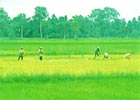 |
Top Destinations |
|
|
|
 |
Travel Tools |
|
|
|
 |
|
|
Thailand hotel travel information and local guide
Agrotourism
 It
is often said that nobody who’s willing to work will ever starve
in Thailand. A 13th century king’s praise for his homeland, inscribed
in stone and memorized by schoolchildren, proclaims that “there is
rice in the fields, and fish in the waters.” Even in hard times like
today, the country’s natural wealth continues to provide hopes and
a livelihood for its sons and daughters. It
is often said that nobody who’s willing to work will ever starve
in Thailand. A 13th century king’s praise for his homeland, inscribed
in stone and memorized by schoolchildren, proclaims that “there is
rice in the fields, and fish in the waters.” Even in hard times like
today, the country’s natural wealth continues to provide hopes and
a livelihood for its sons and daughters.
Fruit and salt farming flourish in the provinces on both coasts of the
Gulf of Thailand. The Eastern provinces receive the southwest monsoon
that makes them greener and wetter than the rest of the country. They
produce quality rambutan,  mangosteen
and some of the best durians for local and overseas markets. Provinces
southwest of Bangkok are also fruit growers, though the list varies from
one to the next, and cottage industries long ago sprung up to absorb oversupplies.
A visit to these quaint little factories offers an opportunity to sample
their products and take home some of the best. mangosteen
and some of the best durians for local and overseas markets. Provinces
southwest of Bangkok are also fruit growers, though the list varies from
one to the next, and cottage industries long ago sprung up to absorb oversupplies.
A visit to these quaint little factories offers an opportunity to sample
their products and take home some of the best.
Thailand’s agrotourism to a large extent shares a boundary with eco
and cultural tourism, since farm life is inseparable from local culture
and heritage. Agrotourism centers run by the Department of Agricultural
Extension offer tours of local farms with nature exploration and home
stay in the villages. Some agro destinations can be enjoyable stops on
a long trip, offering sightseeing, education and shopping opportunities
in one packages.
Buddhist Meditation
 Any
of us have at one time or another found the toll of living in the modern
world hard to bear. Stress, depression and disillusionment are some of
the diseases of modern times that leave us yearning for a solution, a
cure, so to speak. More and more people are turning to meditation as they
fail to find the answer through worldly paths. Any
of us have at one time or another found the toll of living in the modern
world hard to bear. Stress, depression and disillusionment are some of
the diseases of modern times that leave us yearning for a solution, a
cure, so to speak. More and more people are turning to meditation as they
fail to find the answer through worldly paths.
Meditation is found in some form or other in all major religious traditions.
Even those who are not religious use it to focus the mind, to hone it,
so that it works better. In Buddhism, meditation is the integral to the
eight-fold path to enlightenment. One trains one’s mind so that it
can see the four-point Supreme Truth that forms the core of Buddha’s
teachings: suffering, what causes it, the end of suffering, and the path
to that end. Even if you are not interested in Buddhism, meditation is
a valuable training that can be applied to daily life, for it helps with
concentration and when done correctly can lead to a state of peace and
calmness that’s beyond worldly joys.
There are two main branches in Buddhist meditation: samatha (calmness,
concentration) and vipassana (insight), which stresses mindfulness. This
doesn’t mean that the two are entirely separate, since you cannot
be mindful unless you have at least some level of concentration.
The techniques of samatha meditation are many, some older than Buddhism,
others developed after the time of the Buddha. Among the most commonly
practiced here is anapanasati, or “mindfulness with breathing.”
This technique was advocated by the Venerable Buddhadasa Bhikku (1903-1993),
founder of Suan Mokkh Forest Monastery in Surat Thani. Meditators at Suan
Mokkh (Garden of Liberation), follow the 16 steps of anapanasati as laid
down in Pali texts.
Thai Cooking
 Thai
cooking as now enjoyed all over the world is a blend of Asian and European
influences adopted through centuries of trade and diplomatic exchanges.
Thais have traditionally lived close to the land and the waters, and original
Thai cooking reflected that. Main ingredients were rice, fish, vegetable
and herbs. Very little meat was used, and traditionally beef or buffalo
meat was eschewed since the animals were the mainstays of farm life. Thai
cooking as now enjoyed all over the world is a blend of Asian and European
influences adopted through centuries of trade and diplomatic exchanges.
Thais have traditionally lived close to the land and the waters, and original
Thai cooking reflected that. Main ingredients were rice, fish, vegetable
and herbs. Very little meat was used, and traditionally beef or buffalo
meat was eschewed since the animals were the mainstays of farm life.
Thais grilled, baked and stewed their food, until the Chinese introduced
the techniques of cooking with hot oil. European merchants, diplomats
and missionaries also contributed a lot to the cuisine, starting right
after their arrivals in the 16th Century. And we all have the Portuguese
to thank for introducing chilies to Thai kitchens. Curries and spices,
on the other hand, were brought here by the Indians. Over the years Thai
cooks have added their own ingenuity, substituting hard-to-find ingredients
with what’s available locally and adapting the recipes to suit Thai
palates.
Muay Thai
 The
history of Muay Thai is interwoven with the history of the Thai people.
A gentle, peace-loving people, for centuries Thais had to defend themselves
and their land from aggressive powers. They developed a form of close,
hand-to-hand combat best suited for the kind of rough-terrain battle they
were fighting. Over time it became a rite of passage for Thai men to take
up training in this martial art. King Naresuan the Great (1555-1605),
one of the country’s most celebrated warrior-heroes, is believed
to have been an excellent boxer himself, and it was he who made Muay Thai
a required part of military training. Another milestone in the history
of Muay Thai was the triumph of Nai Khanom Tom over 10 Burmese boxers
in 1774. Taken captive after the Thai capital fell in 1767, Nai Khanom
Tom was picked to fight before the Burmese king. After defeating ten of
them in a row, he was freed and returned home a hero. The
history of Muay Thai is interwoven with the history of the Thai people.
A gentle, peace-loving people, for centuries Thais had to defend themselves
and their land from aggressive powers. They developed a form of close,
hand-to-hand combat best suited for the kind of rough-terrain battle they
were fighting. Over time it became a rite of passage for Thai men to take
up training in this martial art. King Naresuan the Great (1555-1605),
one of the country’s most celebrated warrior-heroes, is believed
to have been an excellent boxer himself, and it was he who made Muay Thai
a required part of military training. Another milestone in the history
of Muay Thai was the triumph of Nai Khanom Tom over 10 Burmese boxers
in 1774. Taken captive after the Thai capital fell in 1767, Nai Khanom
Tom was picked to fight before the Burmese king. After defeating ten of
them in a row, he was freed and returned home a hero.
|
|
 |
Travel
Guides |
|
|
 |
|

